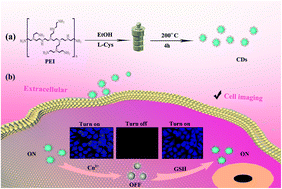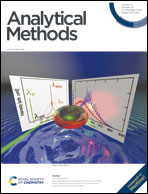An “on–off–on” selective fluorescent probe based on nitrogen and sulfur co-doped carbon dots for detecting Cu2+ and GSH in living cells†
Abstract
The abnormal level of Cu2+ or GSH can cause variety of neurodegenerative diseases in humans. Thus, the selective and sensitive detection of Cu2+ and GSH has inspired intensive research efforts in biological sample analysis fields. Herein, an “on–off–on” fluorescent probe based on nitrogen and sulfur co-doped carbon dots (N,S-CDs) has been successfully prepared for the detection of Cu2+ and GSH. The “turn-off” process of fluorescence in the presence of Cu2+ ions was induced by forming a non-luminescent ground state complex due to the interaction between surface groups of the probe and Cu2+ ions. Moreover, the strong coordination between GSH and Cu2+ could destroy the structure of the complex and restore the fluorescence to “turn-on”. This fluorescent probe had excellent selectivity and high sensitivity toward Cu2+ and GSH with the limits of detection (LODs) of 38 nM and 41 nM. More importantly, the as-prepared N,S-CDs served as an efficient fluorescent probe for not only detecting Cu2+ ions in lake water and tap water, and GSH in BSA solution, but also sensing Cu2+ and GSH in living cells. Therefore, these N,S-CDs could be considered as a promising fluorescence probe candidate for environmental monitoring and biological imaging.



 Please wait while we load your content...
Please wait while we load your content...